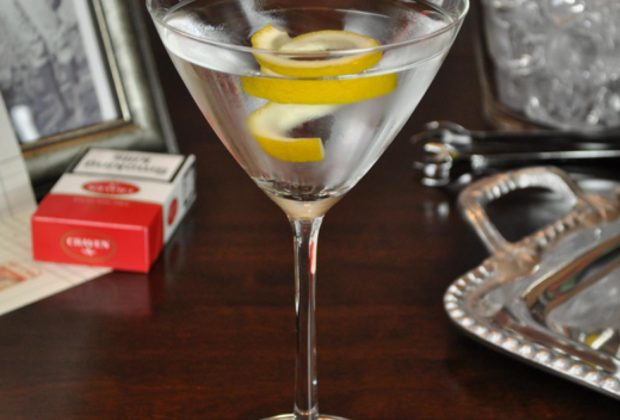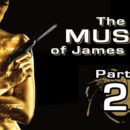THE GOOD LIFE -- Welcome to ‘The Cocktails of James Bond’ a six-part series on the specific cocktails that James Bond enjoyed. I focused on six signature cocktails that seemed to personify Bond, and also gave an understanding about the world of mixology in general. So here is the first, and possibly the most obvious, The Vodka Martini.
Why was James Bond such a vodka enthusiast?
Two reasons come to mind. The first has to do with the emergence of vodka during the time of Ian Fleming. In the early days, most Vodkas were made from potatoes, and it was not known for being a high-quality liquor. Beginning in the 1950s and 60s, more distinctive vodkas were being made from grain, and primarily in areas of Eastern Europe including Poland and Russia, which may explain why our Cold War hero is so often associated with vodka.
Today, almost all vodkas are made from a fermented mash of grain, and distilled at a very high proof of about 190 or higher, and then distilled even further in order to neutralize the flavor.
Vodka is designed to be a neutral spirit, which means it’s essentially flavorless. This may lead some to wonder, if vodka is supposed to be flavorless, then why are there so many brands and varieties to choose from? One answer is the wide range in quality. While vodka snobbery may seem like a simple pretense, many enthusiasts will confirm that certain vodkas taste and feel better than others. This is due to many factors, such as distillation. I can also name a few barflies who can verify that higher quality vodkas will leave less of a hangover.
The neutral flavor of vodka also leads to debate among cocktail aficionados. Some will argue that vodka is highly over-rated, precisely because it’s a flavorless alcohol, while others may tout the versatility of vodka as the reason it lends itself so effortlessly to a wide range of cocktails, including your simpler, two-ingredient cocktails, such as Cape Cods, Greyhounds, Vodka Tonics, and so on.
The other reason that James Bond was a connoisseur of vodka lies simply in its changing popularity in the 1950s. Before vodka became so popular, gin was the old standby, especially in London. Most brands of gin found today are labeled, ‘London Dry.” Leave it to James Bond break with tradition, and eventually change the very landscape of cocktails everywhere. Today, vodka is the most popular liquor sold anywhere in the world, by far.
The debate over the merits of vodka versus gin may also be the reason for the confusion over the ingredients of a genuine Martini, making it one of the most widely known, but often misunderstood, cocktail.
THE MARTINI
I can recall being a young man in my mid-twenties, with an early fascination of cocktails, completely mesmerized at the sight of the more sophisticated patron ordering a Martini.
There was just something about the simple, yet elegant, look of this clear cocktail swirling around in the classic stemmed-glass, and hearing these connoisseurs order their beloved cocktail with such specificity and attention to detail, while calling upon an entire terminology dedicated to one simple cocktail. While most of the clientele only need specify, “bottle or draft,” the Martini drinker would say, “a medium-dry Boodles Martini, straight up, and a little dirty.”
What is a Martini?
Just the word “Martini” sounded like something infinitely refreshing, yet incredibly complex. It wasn’t until many years later that I discovered that the Martini is actually one of the simplest cocktails ever created. When I give an instructional lecture on the Martini, I grab the bottles of gin and vermouth from my speed rack to illustrate its simplicity. I’ll raise the gin and say, “Here is your steak,” raise the vermouth and say, “and here is your seasoning.”
When explaining the Martini to young, potential mixologists, I like to start the discussion by asking them to recall how James Bond orders his Martini. The classic cocktail order of “Vodka Martini, shaken, not stirred,” reveals a great deal about what the traditional Martini really is.
When it doesn’t go without saying, James Bond specifies a Vodka Martini. Therefore, we can assume that he is ordering a variation on the traditional Martini, which is made from Gin. The classic Martini is made up of two ingredients: gin, with some dry vermouth added as a flavoring, or a “spice.” Vermouth is a perfect complement to the herbal qualities of gin. The amount of vermouth that is added, (better known as the “dryness” of the Martini) is based simply on personal preference, as we will discuss.
Furthermore, as the iconic phrase, “Shaken, not stirred” implies, the traditional Martini was stirred. Think back to those classic black-and-white films where one of the impeccably dressed characters would announce that they were going to “mix a batch” of Martinis.
The debate over ‘shaken, not stirred’ still rages today, but we’ll discuss the merits of each technique later on.
Preparing a Martini
What started out as a very simple cocktail, has certainly evolved over time. Every Martini enthusiast will ask for his cocktail to be made to certain specifications, making the final product unique to each person’s individual palette. Here’s a little bartender’s insight: if a customer walked up to my bar and meekly requested, “A martini, please,” then my immediate assumption is that I’ve just met a man (much like myself in my early twenties) who has no idea what a Martini is, and is curious to see what all the fuss is about. A more seasoned martini drinker will boldly order, “A medium-dry, Bombay Sapphire Martini, straight up, with olives.” So to all you younger guys, get to know your martini preference, and order with confidence.
There are five essential variables involved with preparing (or ordering) a martini. So here’s what you need to know:
Gin or Vodka?
As we mentioned earlier, the rage of the Vodka Martini has lead to great confusion over the ingredients of this once simple cocktail. A bartender can no longer assume that a request for a Martini automatically implies gin. He must always ask his customer which type he or she is asking for. Which leads directly to the second question…
Which Brand?
While it’s certainly a good rule of thumb to always use good-quality liquor, there are some simple cocktails wherein the bartender can get away with grabbing whichever no-name booze resides in the speed-rack; the Martini is not one of them. Any time you are preparing a cocktail where the spirit is the primary ingredient, (and I can think of no better example than the Martini,) then you need to stick with high-quality liquors, and your Martini drinker will very likely have a preferred brand.
How Dry?
Here’s a perfect example of the vernacular that defines the unique qualities of the Martini. Put simply, the “dryness” of a Martini refers to the amount of dry vermouth to be used. The more ‘dry’ the Martini is requested, the less vermouth is needed. More dryness equals less vermouth.
But, how dry is ‘dry’? There is much debate over the exact measurements of the vermouth versus spirit. Many bartenders will differ greatly on their interpretation of ‘dry,’ ‘medium-dry,’ and ‘very dry,’ and exactly how much vermouth this translates into. Most recipes will offer different ratios–anywhere from about three parts gin to one part vermouth, to five or even six parts gin to one part vermouth, and so on.
Recently, many bartenders have grown gun-shy with vermouth. They add the tiniest amounts of vermouth, or sometimes none at all. Some will translate dryness into actual ‘drops.’ Perhaps a ‘medium-dry’ martini translates into three drops of vermouth, ‘dry’ translates as two drops, and ‘very-dry’ as a single drop. I have actually heard of patrons request an ‘extremely dry’ martini, to which the bartender complies by ceremoniously waving the bottle of vermouth over the cocktail, without adding a single drop.
I blame the irrational fear of vermouth on the popularity of the Vodka Martini, but more on that later.
So who is right? Of course, the correct answer lies simply in the way your guest likes his or her Martinis. The ‘right’ way is simply a matter of personal preference. However, your patron will naturally be relying on you to interpret his or her wishes, without having to dictate exact measurements. Which brings us back to our original question; how much is the correct amount?
In the end, it boils down to a matter of opinion, and I’ll gladly offer up my own.
For a Gin Martini, I like to use a hearty splash of vermouth. As I said earlier, the gin is your steak, and the dry vermouth is your seasoning. If a customer orders a Martini, and asks for it to be ‘medium-dry (or if the dryness isn’t specified at all), then I will use about a 5 to 1 ratio; 2.5 ounces of Gin, and one half ounce of Vermouth. Since I’m probably in a hurry, and not planing to physically measure out my percentages, I’ll probably just use a heavy ‘splash’ of Vermouth. If my customer says ‘dry,’ then my splash will be reduced to a dash. For ‘extra-dry,’ my dash will be reduced to a single drop.
For a Vodka Martini, I will use the same general theory, but with smaller amounts of vermouth. As we mentioned earlier, vodka was intended to be to be a neutral spirit. When we use a ‘spice’ for cooking, then we’re trying to bring out the natural, inherent flavors of the dish. So if vodka was created and painstakingly distilled in order to be flavorless, then why are we adding a spice to a spirit which was meant to have no distinct flavor?
Therefore, if a customer requests a ‘medium-dry Vodka Martini,’ I use a dash of Vermouth, while ‘dry’ may mean one or two drops. If a customer has emphasized ‘extra-dry’ or even ‘extremely dry,’ I will take this as an indication that they really want no Vermouth at all. There’s absolutely nothing wrong with serving your guest an ice-cold vodka in chilled cocktail glass if this is what he or she wishes.
As a side note, there are some Martini recipes that will suggest pouring a little bit of dry vermouth into the cocktail glass, swirling it to coat the inside of the glass, and then discarding the excess vermouth, before pouring your chilled gin or vodka into the glass. This is sometimes referred to as the ‘In and Out Martini.’ While some may suggest that this will leave the “correct” amount of vermouth in the glass, others feel that this method will retain two separate flavors in the glass, and for a true Martini, the two ingredients should be infused completely to create one singular flavor.
Shaken or Stirred?
As we also mentioned earlier, the classic Martini was stirred. But, because of the ‘shaken, not stirred’ phenomenon, most bartenders today will shake a martini. Once again, leave it to James Bond to change the landscape of cocktails forever. So which method correct?
There was a great episode of the show The West Wing that featured an exchange between the President, played by Martin Sheen, and one of his subordinates, played by Dulé Hill.
Hill remarked that he had just purchased a copy of On Her Majesty’s Secret Service, revealing himself to be a James Bond fan. To which, Sheen asked, “Do you know what’s messed up about James Bond?” I loved Hill’s less-than-amused expression as he responded coldly, “Nothing.” Sheen continued, “‘Shaken, not stirred’ will give you cold water with a splash of gin and dry vermouth. The reason you stir it with a special spoon is so you don’t chip the ice. James is ordering a weak Martini and being snooty about it.”
Just as I was about to express my outrage that someone had actually dared question the cultivation of James Bond himself, a fleeting thought entered my mind: “Could he be right?” While we understand that Martin’s Sheen’s character failed to mention that Bond drinks a Vodka Martini, rather than a Gin Martini, I had to confess that he did make a good point.
Like many Martini drinkers, I’ve had the experience of having a young bartender shake my Bombay Sapphire with such length and vigor that there was nothing left but, “cold water with a dash of gin and dry vermouth.” Bartenders love to get those shakers up in the air, and proudly rattle the ice loudly, causing the other customers to look over with curiosity, and perhaps consider the idea of switching to the more distinguished (and more expensive) cocktail themselves.
So which is the right way? Again, the ‘correct’ answer is simply a matter of personal preference, but each bartender will have his or her own theory, and once again I will share my own: To shake or stir a Martini depends on the spirit, and therefore, I will stir traditional Gin Martinis, and I will shake Vodka Martinis. Here’s why:
We’ve all heard the expression, but whether or not shaking a Martini will actually ‘bruise the Gin’ is an argument for another day. However, as Sheen’s character points out, the traditional ‘bar spoon’ is curled in a way that will stir the mixture without chipping the ice, therefore preventing water from being added to the cocktail. Stirring should get your cocktail as cold as you want it, without chipping or melting the ice, and thereby diluting the liquor.
On the other hand, warm vodka is just not palatable. Vodka needs to be served iced cold. When James Bond requests his Martini to be shaken, he’s asking for the drink to be made very, very cold. Shaking a Martini with ice is the surest way to make it as cold as possible. Also, the droplets of water that will be added to the mixture through shaking will be just enough to take the edge off the otherwise harsh Vodka.
Therefore, I stir Gin Martinis, and I shake Vodka Martinis.
Which Garnish?
The last thing you need to know when preparing and serving a Martini, is the garnish. While the modern Martini culture may be expanding to include many new and exciting garnishes, the traditional Martini will be garnished with olives or a twist of lemon peel. (I always remind my young bartending students to simply recall the book, “Oliver Twist.”)
So which garnish is correct? As always, it’s a matter of personal preference, but if the customer has not offered a specific request, I will add olives to a Gin Martini, and add a slice of lemon peel to Vodka Martinis, as I personally believe these to be the perfect complements.
PREPARING THE VODKA MARTINI
1. Take a cocktail glass and fill it with ice to chill. Set it aside.
2. Take your cocktail shaker (or a pint glass) and fill it about ¾ with ice.
3. Add your vodka. You can measure out 3 ounces of vodka, or you can simply fill the glass enough to fill a cocktail glass, usually about to the top of the ice. (Bartender’s Trick: Fill a cocktail glass with water, and then pour the water into your ice-filled shaker. This will determine your ‘fill line.’)
4. Add your vermouth. A quarter-ounce splash should give you a good medium-dry Martini.
5. Place the top onto your shaker (or your Boston-style shaker over your glass), and shake vigorously. Shake it until frost forms on the metal shaker.
6. Empty the ice from the cocktail glass, and strain the Martini into the cocktail glass.
7. Garnish with a lemon twist.
8. Serve and enjoy.











Top 5 Rejected James Bond Theme Songs
The "No Time To Die" Review